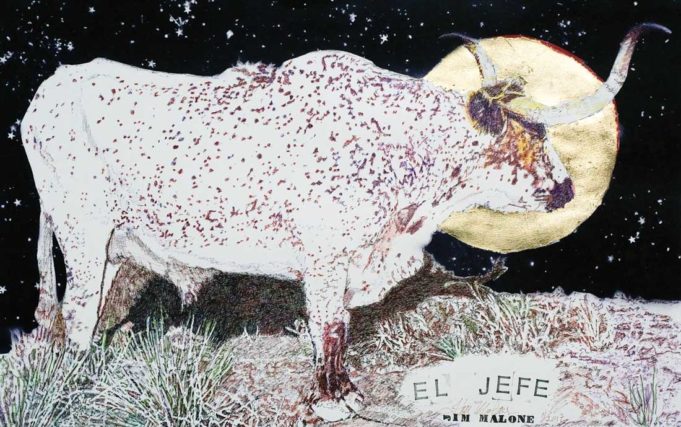Artspace 111’s location on Hampton Street is as far east as you can go and technically still be downtown, and Fort Worth’s multistory buildings can easily be seen from the gallery’s front patio. For City Symphony, Artspace brings together Daniel Blagg, Maureen Brouillette, Pat Gabriel, William Greiner, and Kim Cadmus Owens to share paintings and prints that reveal their observations of the urban landscape. And nestled in the far back gallery, Jim Malone’s hidden gem of a solo exhibition, Gold Rush, shifts the perspective from city views to panoramas of wide-open spaces.
In each of photographer William Greiner’s four large “Road Sign” paintings, there’s a yellow swath of paint that becomes either the foreground or background, creating long strokes worked into and out of other sign-associated colors that make up the composition. It’s the kind of yellow that recalls the long driver’s-side strip of most freeways and hints at a connection to cityscapes, reinforcing the show’s theme. Considered out of the context of road signs, the paintings are abstractions of pure color and feel like misarranged puzzle pieces, a disorienting array that forces the eye to linger as it tries to connect each piece with the other. The inclusion of the photographs that Greiner used as points of reference seems unnecessary and only forces those beautiful lines back into the ordinary shapes of mundane signs that say turn left or right.
Some other prints and paintings in the exhibition lean into the city motif unambiguously, like the nostalgia-dripping canvases by Daniel Blagg (and others) and the prints by Dallas’ Kim Cadmus Owens, which also make connections to the urban landscape but in different ways. In her series “Lost/Found,” Owens erases whole sections of city architecture, raining down prisms of color that abruptly terminate as lines around the negative spaces that make up the buildings in each image. The suite of letterpress prints have subtle details of surface relief that can only be fully appreciated when viewed in person, and the nuance of colors created by vibrating each line slightly out of register in the printing process really makes for moments of awe.
She then switches gears in two of her other works here, revealing a more grimy spin on the dark side of nostalgia. Acrylic and carbon paintings on wood panels from 2009, “Real” and “Grand” are gray and dull except for moments of blue and gold in each, as old building signs defy the wear and tare of city smog and acid rain to remind us of the roots of our concrete jungles.
Moving into the back gallery where Malone’s landscape paintings are, the gilded glow starts to come into focus. It’s the moonlit desert in “Mt. D’oro” that is glowing. There are stars everywhere in the big Texas sky, and the desert floor becomes undulating mounds of pure gold. The towering rock formation in front of me has stark, contrast-y shadows and white-hot highlights. A Texas longhorn looks toward the mountain, its bespeckled hide forming a constellation all its own. There is a cactus bloom off to the right, defying the stark terrain that hides any evidence of life. Mount D’oro ascends, forming a triangle with the longhorn and the cactus and, extending toward the top, offers me a way out of the painting. But I don’t want to leave.
This is how Malone gets you. The trap is obvious and the exits equally so, but the longer I looked, the harder it was to stop looking.
Malone’s gilded canvases combine colored pencils with painting and drawing, resulting in strange, sometimes hallucinogenic effects. In “Road to Heaven,” a golden path stretches toward the horizon. Off in the distance, a yolk-colored sun appears to rise from behind mountains that are barely there. A pensive blue horse and a distracted red one seem to linger, shimmering in the foreground, waiting to take riders down the yellow gold road. The colors are unnatural, and there is a strong feeling of disorientation. But in “Heaven,” there are enough familiar elements to keep you grounded.
All of the paintings in Gold Rush are composed with gold leaf, creating rivers, petals, moon, and sky. In Malone’s hands, the omnipresent gilding becomes less decorative and feels more like the presence of the artist in the work.
In “Rio D’Oro,” a lone figure is set afloat on a golden river, his blue tipped paddle coursing him along under a star-studded black sky. Traces of red paint struggle to the surface from below the gold leaf, creating a swirling section of canvas that plays against the slight curvature of the horizon. The figure seems to float on a thin layer of gold in the middle of space, with seemingly no direction or urgency. Malone’s paintings give that sense of calm, and in the moments of pause that they convey, we are reflected in those golden, shiny surfaces.
City Symphony and Gold Rush
Thru Mar 17 at Artspace 111, 111 Hampton St, FW. Free. 817-692-3228.












